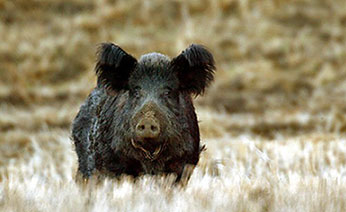Overview

Pigs (Sus scrofa) are native to Eurasia and northern Africa. In the early 1700s Spanish and Russian settlers introduced domestic pigs to California as livestock and many became feral. In the 1920s a Monterey county landowner introduced the European wild boar, a wild subspecies of Sus scrofa into California, which bred with the domestic pigs. The result of these introductions is a wild boar/feral domestic pig hybrid. Until the mid 1950s, wild pigs were unclassified under state law and could be killed with no restrictions. In 1957, wild pigs were designated a game mammal by the State Legislature. The Fish and Game Commission soon established hunting seasons, bag and possession limits, method of take and the conditions for using dogs. In 1992 Fish and Wildlife Code Sections 4650 through 4657 were added that required hunters to possess wild pig license tags while hunting pigs.
Wild pigs currently exist in 56 of the state's 58 counties and can be found in a variety of habitats ranging from woodland, chaparral, meadow and grasslands. Wild pigs are omnivorous, consuming both plant and animal matter. In general, wild pigs feed on: grasses and forbs in the spring; mast and fruits in the summer and fall; and roots, tubers and invertebrates throughout the year.
As with all game species, wild pig behavior tends to change as hunting pressure increases. Where hunting is infrequent wild pigs may be active during the day. With moderate hunting, pigs tend to bed down around sunrise and become active again in late afternoon. In areas with heavy hunting pressure pigs are generally active only at night. Depending on pig density and abundance of cover, wild pigs tend to leave an area where hunting pressure becomes severe. See the state map of tag returns(opens in new tab) for pig take per county based on the wild pig tag returns for hunting season.
About half of the state is under private ownership and wild pigs occur mainly on private lands, but many public areas in the state have a fairly high rate of return on pig tags. In the northern part of the state the Tehama Wildlife Area has a modest return. In the central part of the state, Cow Mountain Management Area and Laguna Mountain also do well. The military bases (Fort Hunter Liggett and Camp Roberts) are responsible for 35% of the public land take. See the CDFW's Guide to Hunting Wild Pigs in California (PDF)(opens in new tab) for more information on behavior, biology and how to hunt wild pigs, plus maps and contact information for wild pig hunting on public lands, recipes and more.
BigGame@wildlife.ca.gov
See also, Wild Pig Hunting Information